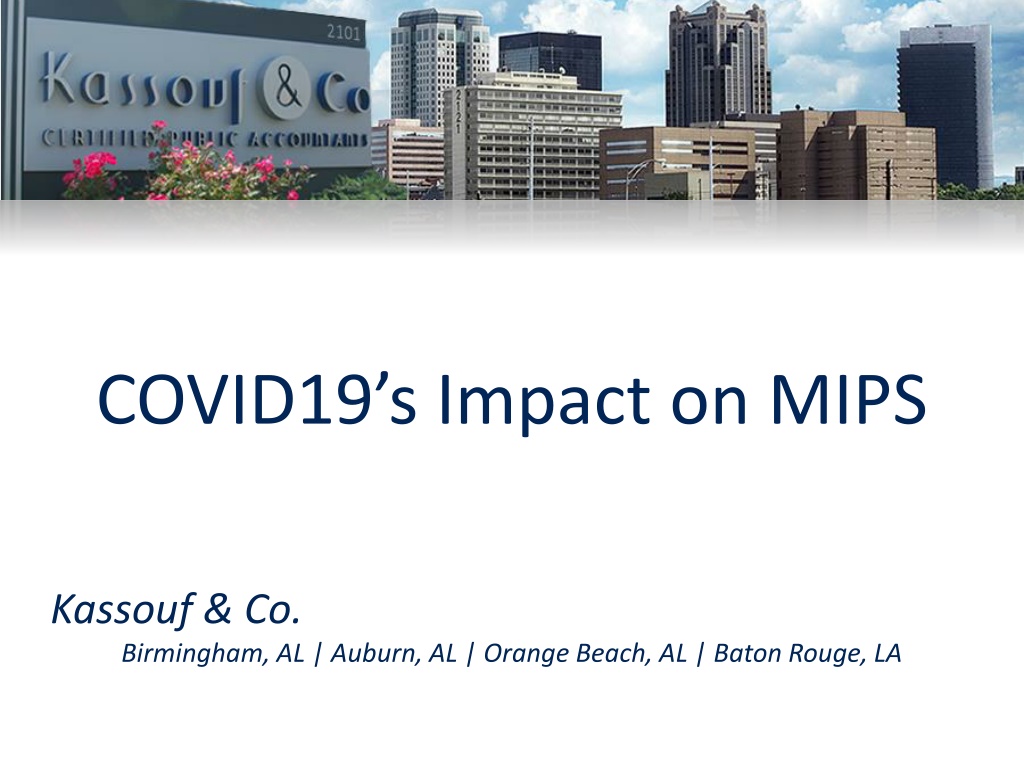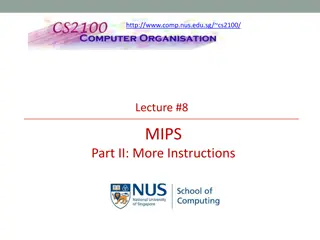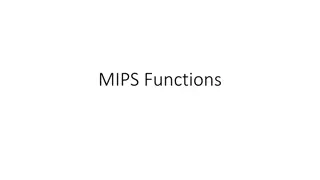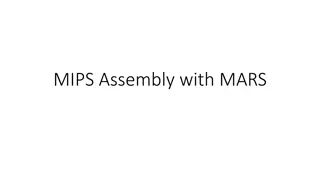COVID-19 Impact on MIPS in Birmingham & Beyond
Impact of COVID-19 on MIPS in Kassouf & Co. covering Birmingham, AL, Auburn, AL, Orange Beach, AL, and Baton Rouge, LA. Gain insights into eligibility criteria, reporting requirements, and adjustments for the years 2019 and 2020. Stay informed about program rules and regulations as they evolve in response to the ongoing pandemic.
Download Presentation

Please find below an Image/Link to download the presentation.
The content on the website is provided AS IS for your information and personal use only. It may not be sold, licensed, or shared on other websites without obtaining consent from the author.If you encounter any issues during the download, it is possible that the publisher has removed the file from their server.
You are allowed to download the files provided on this website for personal or commercial use, subject to the condition that they are used lawfully. All files are the property of their respective owners.
The content on the website is provided AS IS for your information and personal use only. It may not be sold, licensed, or shared on other websites without obtaining consent from the author.
E N D
Presentation Transcript
COVID19s Impact on MIPS Kassouf & Co. Birmingham, AL | Auburn, AL | Orange Beach, AL | Baton Rouge, LA
Disclaimer The information presented in these slides were accurate as of the time of completion. Program rules can change at any time and ongoing education is essential to stay up to date on current rules and regulations.
COVID19 Impacted Everything COVID19 Impacted Everything 2019 Reporting Year 2021 Adjustment Year 2020 Reporting Year 2022 Adjustment Year
2019 AND 2020 Eligibility 2019 AND 2020 Eligibility Bill more than $90,000 for Part B covered professional services, and See more than 200 Part B patients, and; Provide 200 or more covered professional services to Part B patients. Based on 2 Determination Periods Must be eligible in BOTH determination Periods If a Provider meets 2 of the 3 criteria above they can OPT IN, making them subject to MIPS scoring and Adjustments A provider can also Voluntarily Report, which would not make them subject to MIPS adjustments You can check eligibility on the QPP website: qpp.cms.org Kassouf & Co., P. C. 2020 Reporting Period 2022 Payment Period
2019 Reporting Review of Requirements Review of Requirements (before COVID19) (before COVID19) Performance Threshold set at 30 points Exceptional Performance Threshold at 75 points Maximum Adjustment Range (-7% to +7%)
2019 Reporting 2019 Reporting What Just Happened? What Just Happened? Submission Window for 2019 Reporting was extended to April 30, 2020 (from March 31) CMS Instituted an Automatic Extreme and Uncontrollable Circumstances Hardship for Individuals. Groups/Virtual Groups- (required application) Extended Deadline for 2019 Data Validation Execution Report submission from QCDR and Qualified Registries
2019 Reporting-Extreme and Uncontrollable Circumstances Eligible Individuals Eligible Individuals Eligible Individuals No Data Reported Automatically receive a NEUTRAL score All performance categories are weighted to 0% Eligible Individuals- Data Reported Voids the 0% weight for categories reported and overrides the hardship for those categories Eligible Individuals- Submitted Partial Data before COVID19 Crisis, but was not able to complete reporting Could submit application between April 3 and April 30 for E&U hardship If approved, would received Neutral Score, overwrite data previously submitted If partial score was at least 30 points, no need to apply.
2019 Reporting-Extreme and Uncontrollable Circumstances Groups and Virtual Groups Groups and Virtual Groups Automatic Extreme and Uncontrollable Circumstances did NOT apply to Group Participation Applications were available for Groups to apply between April 3 and April 30, 2020, if they were not able to report or complete reporting due to COVID19 If approved, it voided any previously submitted data Group was given a neutral score
2019 Reporting- Extreme and Uncontrollable Circumstances Reweighting of Categories Reweighting of Categories Under Hardship- Cost Category is reweighted to 0% regardless if you submitted data.
2021 Adjustments 2021 Adjustments- - Summary Summary 0-29 Points (Negative Adjustment) 30 Points (Neutral Adjustment) 75+ Points (Exceptional Performance Bonus ) Regular payment adjustment subject to budget neutrality Exceptional Performance Bonus- not subject to budget neutrality
2021 Adjustments 2021 Adjustments How do the Points Translate? How do the Points Translate? The lowest 25% of scores below Threshold will get maximum penalty
2021 Payment 2021 Payment No Penalty if . No Penalty if .
2021 Payment 2021 Payment- - Potential Penalty Potential Penalty
2021 Payment 2021 Payment- - Extreme and Uncontrollable Circumstances Extreme and Uncontrollable Circumstances Important to remember that the Extreme and Uncontrollable Circumstances Policy implemented by CMS for 2019 Reporting due to COVID19 does NOT change the Budget Neutrality Requirement. What does that Mean? Less Penalties = Less Incentives
2020 Performance Year 2020 Performance Year
2020 Performance Period and Weight 2020 Performance Period and Weight NO CHANGE NO CHANGE Performance Period: No change from 2019 Quality 12 months Cost 12 months Improvement Activities Continuous 90 days Promoting Interoperability Continuous 90 days PERFORMANCE CATEGORY WEIGHTS Improvement Activities 15% Quality 45% Promoting Interoperability 25% Category Weight for 2020 Reporting Period is same as 2019 Quality 45% Cost 15% Improvement Activities 15% Promoting Interoperability 25% Cost 15%
2020 Performance Scoring Tiers 2020 Performance Scoring Tiers
2020 Performance 2020 Performance - -Quality Details Quality Details 2 3 1 4 Measures can be removed if no longer meaningful Can no longer be maintained Do not meet case minimum for 2 years Not available to report Can submit via multiple submission types. If submission by more than one type, then the highest points will be used Data Completeness Requirement- 70% of ALL Patients (70% of Part B only if submitting by claims) Extremely Topped Out Measures (98% performance or greater) can be removed in the next year
2020 Performance 2020 Performance Quality Point Assignment Quality Point Assignment Flat Benchmarks can be assigned if true benchmarks are determined to incentivize unsafe patient behavior. (Based on 10 point deciles) Flat Benchmarks are applied to ALL collection types. Kassouf & Co., P. C. 2020 Reporting Period 2022 Payment Period
So what if you submit less than 6 measures? So what if you submit less than 6 measures? Groups that submit 5 or fewer measures and do not meet CAHPS will have the quality denominator reduced by 10 and the missing measure(s) will receive 0 points. Example: 6 Measures Example: 6 Measures Example: 4 Measures Example: 4 Measures Example: 5 Measures Example: 5 Measures Points Submitted: Measure 1 Measure 2 Measure 3 Measure 4 Measure 5 Measure 6 Quality Score = 32/60 or 53% Points Submitted: Measure 1 Measure 2 Measure 3 Measure 4 Measure 5 Measure 6 Quality Score = 21/50 or 42% Points Submitted: Measure 1 Measure 2 Measure 3 Measure 4 Measure 5 Measure 6 Quality Score = 29/50 or 58% 5/10 4/10 5/10 7/10 8/10 3/10 5/10 4/10 5/10 7/10 0/10 0/0 5/10 4/10 5/10 7/10 8/10 0/0
2020 Performance 2020 Performance- - Promoting Interoperability Promoting Interoperability
2020 Performance 2020 Performance- - Promoting Interoperability Promoting Interoperability No More Base Points- all based on Performance Submit a yes to the Prevention of Information Blocking Attestation, Must Use 2015 CEHRT Submission of Numerator/Denominator or Yes/No Clinicians are required to report on a shorter list of measures from Specified Objectives Submit a yes to the ONC Direct Review Attestation; and Submit a yes for the security risk analysis measure Objectives: eRx HIE Provider/Patient Exchange Public Health and Clinical Data Exchange Bonus Points for Query of Rx Drug Monitoring
2020 Performance 2020 Performance - -Promoting Interoperability Promoting Interoperability Automatic Reweighting for category remains the same as Year 3 0% - NPs, PAs, CRNAs, CNs, PTs, OTs, Speech Path, Audiologists, Clinical Psychologists, Dieticians 0% - 50% or more of patient encounters occurred in places where there is no control over CEHRT used 0% - Non Patient Facing, Hospital Based or ASC based Automatic Reweighting for Extreme and Uncontrollable circumstances (Natural Automatic Reweighting for Extreme and Uncontrollable circumstances (Natural Disasters Disasters- - auto assigned by Zip code) auto assigned by Zip code) Can Apply for a PI Hardship Exception Can Apply for a PI Hardship Exception- - Applications for PI Exceptions are due by December 31, 2020 MIPS eligible clinician in a small practice MIPS eligible clinician using EHR technology decertified in the year Extreme and uncontrollable circumstances- (Lack of Access, Internet or Insufficient Internet) Lack of control over the availability of CEHRT NOTE: NOTE: If providers DO report measures in any of these situations, they will NOT reweight to 0% 2020 Reporting Period 2022 Payment Period
2020 Performance 2020 Performance - - Cost Category Cost Category Total Per Capita Cost Total Per Capita Cost and Medicare Spending Per Beneficiary Medicare Spending Per Beneficiary metrics are revised for 2020 Case minimum of 10 for procedural Case minimum 20 for Acute Inpatient CMS increased the number of episode-based measures from 8 to 18 by adding 10 new measures: Acute Kidney Injury Requiring New Inpatient Dialysis Elective Primary Hip Arthroplasty Femoral or Inguinal Hernia Repair Hemodialysis Access Creation Inpatient Chronic Obstructive Pulmonary Disease (COPD) Exacerbation Lower Gastrointestinal Hemorrhage Lumbar Spine Fusion for Degenerative Disease, 1-3 Levels Lumpectomy Partial Mastectomy, Simple Mastectomy Non-Emergent Coronary Artery Bypass Graft (CABG) Renal or Ureteral Stone Surgical Treatment
2020 Performance 2020 Performance - - Cost Attribution Cost Attribution Measure Attribution: Measure attribution will be different for individuals and groups and will be defined in the applicable measure specifications. TPCC attribution will require a combination of (i) an E&M services and (ii) general primary care service or a second E&M service, from the same clinician group. TPCC attribution will exclude certain clinicians who primarily deliver certain non-primary care services (e.g., general surgery) or are in specialties that are unlikely to be responsible for primary care services (e.g., dermatology). MSPB Clinician attribution will have a different methodology for surgical and medical episodes. No changes proposed for attribution in episode-based measures (existing and new).
2020 Performance 2020 Performance- - Improvement Activities Improvement Activities Must complete Activity for 90 consecutive days If reporting as a Group- at least 50% of the group must complete the Improvement Activity for it to count Not all providers have to complete the Activity during the same 90 day period.
2020 Performance 2020 Performance- - Improvement Activities Improvement Activities CMS added 2 improvement activities: Drug cost transparency Tracking of clinician s relationship to and responsibility for a patient by reporting MACRA patient relationship codes CMS modified 7 improvement activities: Completion of an accredited safety or quality improvement program Anticoagulant management improvements Additional improvements in access as a result of QIN/QIO TA Implementation of formal quality improvement methods, practice changes, or other practice improvement processes Participation in a QCDR, that promotes use of patient engagement tools. Use of QCDR data for ongoing practice assessment and improvements Completion of Collaborative Care Management Training Program CMS removed 15 improvement activities: Participation in Systematic Anticoagulation Program Implementation of additional activity as a result of TA for improving care coordination Participation in Quality Improvement Initiatives Annual Registration in the Prescription Drug Monitoring Program Initiate CDC Training on Antibiotic Stewardship Unhealthy alcohol use Participation in a QCDR, that promotes use of processes and tools that engage patients for adherence to treatment plan Use of QCDR to support clinical decision making Use of QCDR patient experience data to inform and advance improvements in beneficiary Participation in a QCDR, that promotes implementation of patient self-action plans Use of QCDR to promote standard practices, tools and processes in practice for improvement in care coordination Leveraging a QCDR for use of standard questionnaires Leveraging a QCDR to standardize processes for screening Use of QCDR data for quality improvement such as comparative analysis reports across patient populations CPI Participation
2020 Performance 2020 Performance- - New COVID19 Improvement Activity New COVID19 Improvement Activity MIPS COVID-19 Clinical Trials Improvement Activity There are two ways MIPS eligible clinicians or groups can receive credit for this new improvement activity: 1. A clinician may participate in a COVID clinical trial and have those data entered into a data platform for that study; or 2. A clinician participating in the care of COVID-19 patients may submit clinical COVID19 patient data to a clinical data registry for purposes of future study
2020 Reporting 2020 Reporting- - COVID19 Response COVID19 Response Exceptions Issued 6/24/2020 Exceptions Issued 6/24/2020 Extreme and Uncontrollable Circumstances for COVID19 (Application through QPP Website) Application Open Through December 31, 2020 at 8pm ET Allows Clinicians, Groups or Virtual Groups to request the reweighting of one or more MIPS Categories to 0% Applications are Reviewed on a Case By Case Basis If the application is approved, the categories requested will be weighted at 0% UNLESS you submit MIPS data for 2020 Consideration is based on event circumstances and timing affecting the ability for an Eligible Clinician to submit data for EACH category Note: There are automatic hardships for Designated Qualifying Events, but as of 6/24/20; no Event had been identified as such.
2020 Performance Exception 2020 Performance Exception Example Example If an Application is Submitted and Request that Quality and PI be Reweighted to 0%.... Quality- reweighted to 0%, unless you submit Data Promoting Interoperability - reweighted to 0%, unless you submit data Cost - scored regardless if you submit data Improvement Activity - scored regardless if you submit data Use Reweighting Chart to know how much each category is worth
2020 Reporting Requirements 2020 Reporting Requirements
2020 Performance 2020 Performance- - Composite Score Composite Score Quality 45% Cost 15% PI 25% IA 15% If fewer than 2 categories are reported, then score will be set a threshold (45 If fewer than 2 categories are reported, then score will be set a threshold (45 points) with adjustment of 0% points) with adjustment of 0%- - Regardless of ACTUAL points Regardless of ACTUAL points
2022 MIPS Payment Adjustments Baseline payment adjustment: 2019: -/+ 4% 2020: -/+ 5% 2021: -/+ 7% 2022: -/+ 9% (Based on 2020 Performance) Threshold is 45 for a Neutral Score Exceptional performers (scores over 85) are eligible for a share of an additional $500 million pool annually 2026 (and beyond): 0.25% annual baseline payment update Kassouf & Co., P. C. 2020 Reporting Period 2022 Payment Period
2020 Performance 2020 Performance- - MIPS APMs vs. APMs MIPS APMs vs. APMs MIPS APMs are ACOs that still have to report MIPS MIPS APMs are often one-sided risk Some MIPS APMs are considered Advanced APMs if the patient % and revenue requirements are met MIPS APMs have reweighted categories: Quality 50% PI 30% IA 20% Cost 0% If a provider is in a group and a MIPS APM, the APM score always overrides the Group or Individual score, regardless of which one is higher. 2020 Reporting Period 2022 Payment Period
2020 Performance 2020 Performance COVID19 Response to ACOs/ APMs COVID19 Response to ACOs/ APMs CMS removed annual application cycle for 2021 and gave MSSPs an automatic 1 year extension. MSSPs that were required to increase financial risk in 2021 are given the option to maintain current risk levels for another year. Adjusting the accounting methodology of Cost for ACOs to ensure they will be treated equitably , regardless of the number of COVID19 patient encounters 2020 Reporting Period 2022 Payment Period
Audits Data Accuracy Audit: Data Accuracy Audit: Proof that your submitted data matches the reports from your EHR or other source documents Data Validation Audit: Proof that the data on the reports or other source documents actually match what is documented in the chart Kassouf & Co., P. C. 2020 Reporting Period 2022 Payment Period
MIPS Audit MIPS Audit Guidehouse to conduct data validation and audits The request will be sent either email or certified mail Selected clinicians will have 45 calendar days from the date of the notice to send the requested information Contact the Quality Payment Program at QPP@cms.hhs.gov or 866 288 8292 (TTY 877 715 6222) if you have questions
This is About Strategy This is About Strategy How much money is really at stake? What is my Return on Investment? Time System expense Admin Time Only focus on what will get you more Composite Points When looking at group vs individual, consider points and culture What about next year and the year after? Know the Rules- Lots of incorrect information out there Kassouf & Co., P. C. 2020 Reporting Period 2022 Payment Period
Be Ready for Anything Rules can change Anything can happen at any time (refer to first few slides) Early bird doesn t always get the worm
Thank You! Thank You! Joni Wyatt, MHA, MHIA, CPHIMS, FHIMSS Sr. Healthcare Advisor Kassouf & Co jwyatt@Kassouf.com Kassouf & Co., P. C. 2020 Reporting Period 2022 Payment Period

























